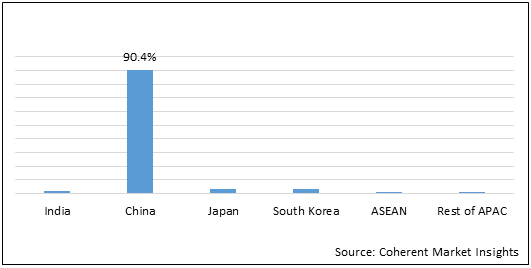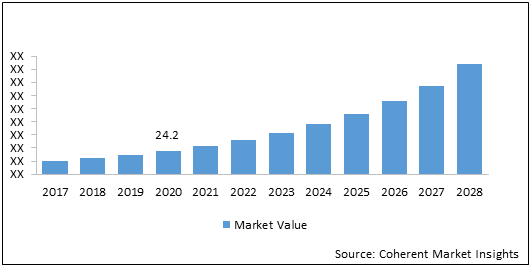In the past, only passenger cars were available under electric vehicles, however, with increasing demand for emission free mass transit, many OEMs have entered the electric bus market. The growth of the electric bus industry is facilitated by the development of advanced charging technologies and decreasing battery prices. OEMs are introducing advanced electric buses that have significant operating range and power output along with modern charging solutions.
The electric buses require advanced charging systems. The increasing demand for sustainable transit solutions and emission regulation has driven growth of electric vehicles which in turn is propelling demand for these charging systems for electric vehicles. The advanced charging systems are reliable, emission free, and less noisy. The charging systems for electric buses are categorized into off-board top-down pantograph and on-board bottom up pantograph. The charging of e-bus usually takes 4 to 12 minutes with an off-board top-down pantograph charging system. Moreover, OEMs have introduced an inductive charging (wireless charging) which does not require any wires/ cable and is an effective way of charging the bus on the go. Ground-based static charging is a type of wireless charging that are used for electric bus charging.
The Korea and Asia Pacific Electric Bus Market is expected to witness significant growth during the forecast period (2021–2028). Governments across the region have launched attractive initiatives and schemes to encourage the fast adoption of electric vehicles to reduce CO2 emissions to help curb pollution. Governments in emerging countries such as India and China have begun tender processes to introduce electric buses in the cities. For instance, in August 2020, under the FAME II program, Government of India approved 5,595 electric buses for several states and city transport undertakings. Also, the government will provide incentives of around US$ 380.5 million to states and city transport undertakings.
Some emerging countries in the South East Asia region are planning to introduce zero emission vehicles. For instance, The Malaysian government is planning to become a production hub for Energy Efficient Vehicles (EEVs) in the ASEAN region by 2025. According to Coherent Market Insight’s analysis, Malaysia is planning to introduce 100, 000 electric motorcycles, 100,000 EVs, and 2,000 EV buses by 2030. Moreover, the Thailand government has drafted an 'Electric Vehicle Promotion Plan for Thailand' under its Thailand Alternative Energy Development Plan 2012-2021 to promote the use of EVs. Such initiatives related to zero emission standards by various governments are expected to drive growth of the electric bus market.
Korea and Asia Pacific Electric Bus Market - Impact of Coronavirus (Covid-19) Pandemic
COVID-19 has significantly disrupted almost all the industries including infrastructure, transportation, oil and gas, manufacturing, and others. To combat COVID-19 pandemic, most of the countries had implemented lockdown restrictions, which are now being eased slowly on phase-wise and industry basis. This has significantly impacted the manufacturing sector, as the facilities across the globe were temporarily shut down.
The threat of COVID-19 crisis is perceived to be larger than the 2007-2008 global financial crisis (GFC). Moreover, legal and trade restrictions, such as closed borders increased the shortage of required parts and limited distribution of supplies. The prices of raw materials such as copper, iron ore, and zinc dropped during the pandemic. As lockdown and social distancing norms were imposed by many governments in Asia Pacific, the supply chain was significantly disrupted. Moreover, due to unavailability of raw materials, limited parts supply coupled with reduced workforce has led OEMs to shut down their production. The need to secure liquidity and reduce overproduction due to the decrease in sales is increasing among OEMs. OEMs are implementing a just-in-time production strategy. Moreover, the end users such as Municipal Corporation are delaying the tenders for electric buses owing to their economic problems. However, in long term governments are planning to provide subsidies and tax benefits for electric buses to boost the electric vehicle industry.
China is expected to hold dominant position in the Korea and Asia Pacific Electric Bus Market during the forecast period.
Statistics:
China held dominant position in the Korea and Asia Pacific Electric Bus Market in 2020, accounting for 90.4% share in terms of value.
Korea and Asia Pacific Electric Bus Market Report Coverage
| Report Coverage | Details | ||
|---|---|---|---|
| Base Year: | 2020 | Market Size in 2021: | US$ 24.2 Mn |
| Historical Data for: | 2017 to 2019 | Forecast Period: | 2021 to 2028 |
| Forecast Period 2021 to 2028 CAGR: | 28.8% | 2028 Value Projection: | US$ 203.7 Mn |
| Geographies covered: |
|
||
| Segments covered: |
|
||
| Companies covered: |
ANKAI, Ashok Leyland Limited, BYD Motors Inc., Edison Motors Co., Ltd., FAW Group Corporation, GILLIG LLC, Higer Bus, Hyundai Motor Company, King Long, Nanjing Jinlong Bus Manufacturing Co., Ltd (Sky-well New Energy Automobile Group Co. Ltd), Olectra Greentech Limited, Scania, Tata Motors, Volvo Group, Yutong, Zhongtong Bus Holdings Co., Ltd. |
||
| Growth Drivers: |
|
||
| Restraints & Challenges: |
|
||
Uncover macros and micros vetted on 75+ parameters: Get instant access to report
Figure 1: Korea and Asia Pacific Electric Bus Market Share (%), By Country, 2020

To learn more about this report, Download Free Sample
Among country, China held dominant position in the Korea and Asia Pacific Electric Bus Market in 2020 and is expected to retain its dominance throughout the forecast period. The launch of technologically advanced buses including 5th-generation electric buses across China is also supporting the market dominance of APAC.
Additionally, China is the fastest-growing country in Asia Pacific electric bus market. The growth of this market is attributed to the high presence of top OEMs including Anhui Ankai Automobile Co., Ltd. (Ankai), Higer Bus, Yinlong Energy, BYD Company, Zhongtong Bus Holding, and Yutong in the country.
Medium (9 to 12m) segment is expected to drive the market growth during the forecast period.
Among size, Medium (9 to 12m) segment is expected to hold dominant position in the Korea and Asia Pacific electric bus market during the forecast period owing to preferred length and higher adoption of 9-12 length electric buses for public transportation. For instance, in February 2019, automotive manufacturer, Tata Motors, has delivered 20 (9m) Ultra Electric AC buses to the West Bengal Transport Corporation.
Figure 2: Korea and Asia Pacific Electric Bus Market Value (US$ Mn) Analysis and Forecast and Y-o-Y Growth (%), 2017 - 2028

To learn more about this report, Download Free Sample
The Korea and Asia Pacific Electric Bus Market was valued at US$ 24.2 Mn in 2020 and is expected to reach US$ 203.7 Mn by 2028 at a CAGR of 28.8% between 2021 and 2028.
Major players operating in the Korea and Asia Pacific electric bus market include ANKAI, Ashok Leyland Limited, BYD Motors Inc., Edison Motors Co., Ltd., FAW Group Corporation, GILLIG LLC, Higer Bus, Hyundai Motor Company, King Long, Nanjing Jinlong Bus Manufacturing Co., Ltd (Sky-well New Energy Automobile Group Co. Ltd), Olectra Greentech Limited, Scania, Tata Motors, Volvo Group, Yutong, Zhongtong Bus Holdings Co., Ltd.
Share
Share
Missing comfort of reading report in your local language? Find your preferred language :
Transform your Strategy with Exclusive Trending Reports :
Frequently Asked Questions
Select a License Type
Joining thousands of companies around the world committed to making the Excellent Business Solutions.
View All Our Clients